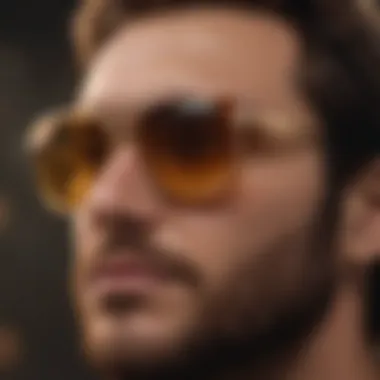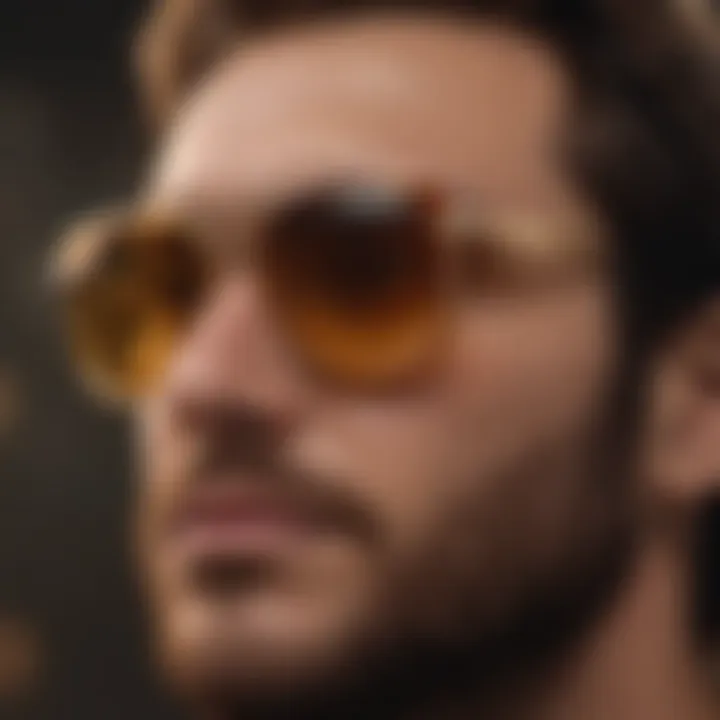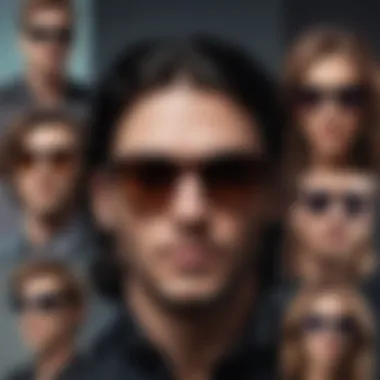The Cultural Impact of Rockstar Shades in Music and Fashion
Intro
Rockstar shades have evolved well beyond mere accessories; they represent a cultural phenomenon steeped in the realms of music and fashion. These bold eyewear pieces not only block the sun but also make a statement, serving as an emblem of rebellion and creativity for countless artists across generations. As these shades transitioned from niche subcultures to mainstream fashion, they became integral to artist personas and left an indelible mark on how we perceive identity in popular culture. Understanding the allure of these iconic sunglasses requires a closer look at the artist profiles that popularized them, the influences that shaped their designs, and the lyrical themes they often accompany.
Artist Profile
Biography and Background
Many artists who rocked shades over the decades came from backgrounds rich in cultural and musical diversity. Take, for instance, the legendary David Bowie. Born in Brixton, London, in 1947, Bowie emerged as a chameleon of the music scene, constantly reinventing his style and sound. His affinity for flamboyant costumes and striking sunglasses mirrored his artistic endeavors. Similarly, the likes of Elton John, with his extravagant outfits and quirky shades, carved out a unique identity that emphasized flair and theatricality. These eyewear choices were not mere fashion statements; they articulated their artistry and marked their departure from conventional norms.
Major Influences and Inspirations
The influences behind rockstar shades often stem from cultural movements and personal inspirations. For instance, punk rock icons like Sid Vicious and Debbie Harry donning their distinctive eyewear echoed the defiance of societal expectations. These glasses became symbols of the anti-establishment sentiments prevalent in the 1970s, allowing these artists to visually communicate their rebellion. In another vein, the glam rock era, epitomized by figures like Marc Bolan and Brian Eno, leaned heavily on androgyny and flamboyance, embracing extravagant eyewear as a representation of their diverse identities.
What’s interesting is how contemporary artists continue this legacy. Today’s pop stars, such as Billie Eilish and Lil Nas X, pick up where their predecessors left off, layering their music with personal stories while wielding shades as both shields and symbols.
"Rockstar shades function as a mirror reflecting the societal beliefs of their time, encapsulating freedom, identity, and rebellion in every frame."
The Cultural Impact of Rockstar Shades
Rockstar shades have played a significant role in shaping music culture, both onstage and off. They serve to heighten the performance experience, captivating audiences and influencing fashion trends. As artists perform in their striking eyewear, they deliver a visual narrative, one that resonates with fans and conveys their larger-than-life personas.
These shades can be categorized into different styles, often aligning with the artist's genre. Oversized aviators might suit a classic rock star, while cat-eyed frames may represent a pop diva or indie musician's edgy allure. The focus on aesthetics reflects the importance placed on visual identity in today's digital marketing landscape, where social media amplifies an artist’s image to global audiences.
Intro
In a world that often equates image with identity, rockstar shades have carved a niche all their own, transcending the realm of simply being fashion accessories. They bridge the gap between rebelliousness and artistry, becoming potent symbols that reflect both personality and the spirit of the music. This article delves deep into the multifaceted allure of these iconic eyewear pieces, offering insights into their evolution, cultural significance, and how they’ve become a mainstay in both the music scene and everyday fashion.
The importance of rockstar shades isn’t merely in their ability to block sunlight but in their powerful ability to convey identity, mood, and lifestyle. Whether worn by an iconic musician or flaunted by a style-savvy individual on the street, these shades carry a weight that few accessories can manage. They speak volumes about who we are—or aspire to be—effortlessly dressed in mystique while simultaneously shouting a sense of individualism. Each pair tells a story, often tied intricately to the artist who donned them, hinting at battles fought, emotions felt, and a culture rebelling against the norm.
This article undertakes a comprehensive exploration of rockstar shades, elaborating on key elements, trends, and how they have woven themselves into the fabric of music history and contemporary identity. With a spotlight on the intricate relationship between the eyewear's design and the personas of the artists who wear them, we will examine how these shades have shifted from the fringes of fashion into the mainstream.
Key Points to Explore:
- The evolution of rockstar shades from their historical origins to modern-day interpretations.
- Influential artists who have shaped and been shaped by this trend.
- The cultural significance of sunglasses in music as symbols of rebellion and identity.
- Current trends and future outlook on this evolving sector of fashion.
As we journey through this exploration, expect to uncover not only the aesthetic appeal but also the substantial impact these shades have had on shaping artistic expression across various genres—an essential facet that resonates deeply with music enthusiasts, aspiring musicians, and students of the craft.
"Shades mysteriously transform identities—one moment you’re a regular Joe, the next you’re an ambiguous icon, setting the stage for intrigue and allure."
Understanding rockstar shades provides a window into the psyche of musicians and the broader socio-cultural landscape, where art and identity intersect robustly.
The Evolution of Rockstar Shades
The evolution of rockstar shades is much more than just a passing trend in eyewear; it reflects deep cultural shifts and evolving artistry within the music world. These unique pieces of accessory have morphed from being mere utilitarian items into powerful symbols of identity, rebellion, and creativity. Understanding this transformation helps us appreciate how closely tied these shades are to the culture of the musicians who wear them. From the distinctly artistic community of the beats to the extravagant glam rockers, shades have played a pivotal role in defining personas and pushing boundaries.
From the Beats to the Glam Rock Era
The journey begins in the 1960s when the beat generation strolled the streets of cities like San Francisco and New York City, donning simple yet striking eyewear. Think John Lennon and his round frames that became synonymous with not just vision but a vision—of peace, love, and the challenges of the societal status quo. This era was marked by a longing for authenticity. Shades weren’t just worn to shield one’s eyes; they were an act of defiance, a way to mark oneself as different in a sea of conformity.
As the music evolved, so did the styles of shades. Enter the glam rock era of the 1970s. Musicians like David Bowie and Marc Bolan embraced flamboyant looks, complete with outrageous eyeglasses that were as much about fashion as they were about function. With rhinestones, vivid colors, and oversized frames, aviators or cat-eyes became visual tropes that radiated individuality and artistry. Such eyewear played into the glam rock persona, creating a spectacle that was both seen and heard on stage.
1990s and the Influence of Grunge
The 1990s brought a significant shift. As grunge took the center stage, a stark contrast emerged. Instead of the outrageous flair of glam rock, bands like Nirvana and Pearl Jam introduced a more relaxed and rugged approach. Sunglasses became more about casual style, comfort, and counterculture rebellion.
Shades walked a fine line between form and function, often sporting muted tones, rectangular shapes, and even survivalist undertones. The iconic look of Kurt Cobain, who famously wore his sunglasses indoors, captured the ethos of a generation that prioritized authenticity over polish. Yet, these simple frames were themselves a statement—an embodiment of the gritty reality of street-style aesthetics.


The Rise of Designer Eyewear
As the new millennium approached, a different trend began to emerge: the rise of designer eyewear. No longer was music the sole determinant of style; fashion houses began to seize control of the narrative. The likes of Gucci, Prada, and Ray-Ban began to release limited edition lines, often intertwined with famous musicians.
These collaborations showcased an intersection of music and high fashion. Celebrities like Beyoncé and Rihanna wielded sunglasses as status symbols, bringing attention to exclusive designs while transforming shades into integral elements of their brand identity. This evolution also showcased a new target demographic—fashion-conscious fans who were willing to invest considerably in the accessories of their favorite artists.
Through each era and shift, rockstar shades have continuously epitomized not just personal style, but the cultural currents that shape them. Each frame tells a story, inspiring future generations of musicians and fashion enthusiasts alike.
Influential Artists and Their Signature Styles
When we talk about rockstar shades, we can't overlook the impact of individual artists. These musicians aren't just playing instruments; they're shaping culture, and their eyewear choices often speak volumes about their identity and artistry. Whether it's a bold statement or a subtle nod to a subculture, rockstar shades often become inseparable from the artists who wear them.
The Bold Vision of John Lennon
John Lennon was more than just a member of The Beatles; he was a cultural icon. His signature round glasses transcended mere function; they embodied the spirit of the 1960s counterculture. Lennon's choice to sport those thin, circular frames was a deliberate anthem for peace and individuality. It seems as if he wore them as a way to challenge societal norms and expectations about masculinity and style.
His shades didn’t just sit on his nose; they became part of his creative arsenal. In the music video for "Imagine," Lennon’s glasses symbolized a vision of harmony and hope. Fans saw it as an invitation to embrace a future filled with possibilities. Those circular frames influenced countless artists after him, solidifying his status as not just a musician but a style icon.
In reflection, Lennon’s eyewear was as revolutionary as the music he produced. As much as his melodies changed the face of rock, so did his glasses.
Stevie Ray Vaughan and the Power of Personal Expression
Stevie Ray Vaughan was known for his fiery guitar riffs, but equally striking was his approach to personal style. Large, flashy sunglasses often adorned his face, adding an extra layer of charisma to his electrifying stage presence. Vaughan's shades created an undeniable connection between his music and his personality.
These weren’t just any sunglasses; they were a reflection of his turbulent journey and artistic evolution. His choice of darker colors and unique shapes conveyed a sense of depth and intensity. They became a way for him to express his raw energy and emotional connection to the music he played.
His iconic look—a mix of scruffy charm and meticulous attention to style—set a new standard. Fans of rock and blues saw that there was power in personal expression, and Vaughan’s oversized eyewear perfectly complemented his ability to command the stage.
Lady Gaga: Pushing Boundaries
Lady Gaga is known for defying expectations, both musically and stylistically. Her eyewear choices often embody avant-garde design, challenging conventional aesthetics. Oversized shades with intricate embellishments or outlandish shapes become part of her performances, enhancing the narratives within her songs.
In the music video for "Bad Romance," Gaga’s shades symbolize the tension between vulnerability and strength. They act as both a shield and a statement, positioning her as an artist who is unafraid to explore complex themes.
Through her daring fashion choices, including those striking rockstar shades, she inspires fans to embrace their individuality. By pushing the envelope, Gaga has redefined what it means to be a pop artist in the contemporary landscape, showing us that eyewear can be more than just an accessory—it can be an essential part of an artist's persona.
"In an industry obsessed with perfection, these artists remind us that personal style can be as impactful as the music itself."
Eyewear, particularly those bold, rockstar shades, becomes a talking point in a world that thrives on visual culture. As we delve deeper into the world of rock and roll eyewear, one realizes that the choice of shade is anything but trivial. It is, in many ways, a reflection of the artist's inner self and societal aspirations.
Trends in Rock and Roll Eyewear
Rock and roll eyewear epitomizes more than just a fashion statement; it is a complex signifier of cultural currents and shifts in public perception. Understanding these trends allows us to grasp how artists use eyewear to project their identity, challenge norms, and connect with their audience. Shades have played a crucial role in the visual representation of the music scene, shaping the way rock stars are perceived both on and off the stage.
Sunglasses Shapes Through the Decades
Taking a trip down memory lane, we can observe how various sunglasses shapes have mirrored the social winds of the times. Each decade brought its own defining aesthetic.
- The 1960s: This era introduced round frames, largely influenced by figures like John Lennon. The lenses were often colored or mirrored, creating an avant-garde effect that screamed artistic rebellion. This shape became symbolic of peace movements, transcending simple fashion.
- The 1970s: Oversized frames hit the scene, immediately associated with glam rock artists like David Bowie. These shades were not just functional; they became an extension of an artist's persona. Styles like aviators also emerged, indicating a shift toward a more masculine and rugged imagery in rock music.
- The 1980s: With the explosion of hair metal, sunglasses became flamboyant, often reflecting the excess of the decade. Shapes like cat-eye and butterfly frames were front and center, embodying a sense of daring and freedom that resonated with the youth of the time.
- The 1990s and 2000s: The rise of grunge sparked a minimalist trend; rectangular and simple frames became popular among artists like Kurt Cobain, suggesting a more subdued kind of rebellion. In contrast, pop-punk stars opted for bright colors and unusual shapes, reminding everyone not to take life too seriously.
- Today: We see a fusion of the past, with vintage-inspired styles making a comeback. Round, oversized, and retro shapes are once again gracing stages, showcasing a yearning for nostalgia. This circularity in fashion indicates how historical trends continue to inform contemporary style choices.
Color Choices and Their Symbolism
Color in rockstar shades goes beyond mere aesthetic appeal; it is laden with meaning. The hues chosen by artists often reflect their musical themes and personal philosophies.
- Black: A classic choice, black sunglasses often symbolize mystery and coolness. Many artists, like Stevie Ray Vaughan, used this timeless color to convey a sense of authority and understated style.
- Bright Colors: The flamboyance of colors such as pink and electric blue is emblematic of the vibrant, outrageous spirit of the 1980s rock scene. Glam rockers, in particular, harnessed these colors to break free from traditional boundaries.
- Earthy Tones: Artists from the folk and indie genres often prefer muted or earth-colored shades. These choices reflect a connection to nature and authenticity in their music, as seen with bands like Fleet Foxes.
- Gradient Lenses: Nowadays, many artists opt for gradient lenses that shift in color. This can serve to represent the transition from past to present, suggesting a journey both in their music and personal life.
"The lenses we wear can tell tales louder than the songs we sing; they are as much a part of our identity as the music we create."


Cultural Significance of Rockstar Shades
Rockstar shades embody a rich tapestry of cultural narratives that extend far beyond mere fashion accessories. They have grown into significant symbols within music history, merging artistic expression with personal identity. At their core, these shades reflect an audacious stance against societal norms, encapsulating the rebellious spirit that defines various music genres. From rock and punk to pop and beyond, glasses have become a universal emblem of defiance, often worn as badges of honor by iconic figures who dare to express their individuality.
Shades as Symbols of Rebellion
From the earliest rockers, shades have stood as a metaphor for rebellion. Take, for instance, the legendary Jimi Hendrix. He adorned bold designs that not only shielded his eyes but also signified a break from convention. The very act of donning sunglasses transformed performers into larger-than-life avatars, allowing them to challenge the status quo of the era.
"Shades aren’t just about protection from the sun; they’re a declaration of refusal to conform."
Rock music, with its roots mired in counterculture, used sunglasses as instruments of defiance. Artists like David Bowie adopted flamboyant styles—think wide frames and reflective lenses—to craft alter egos, making their personal brands inseparable from their eyewear. It’s worth noting that these glasses often went hand-in-hand with provocative lyrics and outrageous performances, working together to create a narrative that pushed societal boundaries.
Through the decades, the allure of sunglasses evolved in parallel with shifts in music tastes. They transformed from symbols of musicians' rebelliousness to reflections of cultural movements. When punk rock emerged, shades became synonymous with an anti-establishment attitude, notably captured by the likes of the Sex Pistols. Worn low on the nose, they represented sophistication wrapped in defiance. Today, rockstars like Billie Eilish carry this mantle forward, as they utilize eyewear to express their distinct aesthetic, whether through oversized frames or vibrant colors.
The Intersection of Fashion and Identity
In the contemporary landscape, rockstar shades have woven themselves into the fabric of personal identity and style. This intersection reveals much about the person behind the shades. For many music enthusiasts and aspiring artists, these glasses are not just an accessory; they are integral to their portrayal of self. The right pair can convey everything from nonchalance to audacity.
Consider the resurgence of vintage designs. Thrift stores teem with gem frames that echo the flair of a forgotten musical era. Young musicians often adopt such styles not solely for their aesthetic appeal but as a profound tribute to the artists who shaped music history. By doing so, they participate in a larger conversation about cultural inheritance and expression.
Shades also function in today’s media-centric world. Social media platforms have become modern-day stages where artists display their personalities. For instance, a post featuring an artist wearing striking sunglasses can spark discussions about authenticity, brand identity, and the nuances of fame.
Moreover, the combination of colors and shapes in eyewear design often ties back to personal stories or influences, tapping into deeper aspects of identity. Wearing specific shades can connect artists to their fans, enmeshing them in a continuous narrative of art and connection.
Marketing and Commercialization
The intersection of marketing and commercialization creates a significant avenue for rockstar shades within the music and fashion industries. As these stylish accessories move from mere functionality to a powerful symbol of identity and expression, branding becomes paramount in influencing consumer perception. It's a phenomenon that affects not just the artists who wear them but also the brands that produce them, tying together a narrative that appeals to music enthusiasts and fashion-forward individuals alike.
The Role of Endorsements by Stars
When celebs strut their stuff wearing certain shades, it’s more than just a fashion statement—it's a marketing strategy that hits home with their fans. Take, for example, the way Elton John flaunts his extravagant eyewear. Artists like him don’t just enhance their looks; they also elevate the brands they choose to represent. In doing so, they create a compelling narrative around those shades, linking them intrinsically to their unique personas.
One could say that endorsements meld functionality and brand prestige. It’s not uncommon for shades on the faces of A-listers to fly off the shelves almost immediately, following the ripple effect of social media. In today's fast-paced digital landscape:
- Fans often seek to mirror their idols’ aesthetics, igniting a broader culture of aspirational buying.
- Social media platforms amplify this reach, allowing brands to engage in viral marketing strategies that resonate with the audience.
In this way, rockstar shades become not only accessories but also statements of allegiance between fans and their favorite musicians.
"Fashion is about something that comes from within you."
— Ralph Lauren
Brand Collaborations and Limited Editions
Brand collaborations provide an exciting and dynamic way to craft exclusive products that cause a buzz. When two iconic entities join forces, the outcome is often nothing short of spectacular. Consider the partnership between Ray-Ban and high-profile artists or the exclusive lines dropped by brands like Prada and Gucci during music festivals. These collaborations create limited edition pieces that become must-have items in the black market of fashion and music culture.
Such partnerships are often steeped in the principles of scarcity and exclusivity. Customers feel a sense of urgency that commonly accompanies limited releases. Individuals may argue that ownership of these unique shades bestows a piece of the artist’s aura upon the wearer.
Key benefits of these collaborations include:
- Elevated Brand Status: Collaborations often lead to increased visibility for the brands involved, engendering positive associations with star power.
- Cultural Relevance: By aligning with musical icons, brands maintain cultural relevance in rapidly shifting trends.
- Consumer Engagement: Limited editions create buzz in the market, driving engagement on social media platforms and generating word-of-mouth excitement.
In essence, when artists lend their style to brands, it transforms regular sunglasses into coveted artifacts of culture. The result is a marketing meld that has sustainability written all over it, creating lasting impressions that resonate with both fans and fashionistas.
Challenges in the Eyewear Sector
In an industry where image and style reign supreme, the eyewear sector faces its share of hurdles that can complicate the allure of rockstar shades. This topic is pivotal in understanding not only the market dynamics but also the cultural sentiments attached to these iconic accessories. The blend of artistry and commerce becomes both a canvas for creative expression and a battleground for authenticity, where individual identity and brand integrity clash amid shifting consumer habits.
Counterfeiting and Imitation


One of the most pressing concerns in the eyewear market is the rampant counterfeiting and imitation of popular styles. Rockstar shades, like other luxury accessories, attract a significant amount of knock-offs. The problem isn’t merely economic but also concerns the essence of originality that musicians and designers strive to convey.
- Quality Assurance: Many counterfeit products lack the quality and craftsmanship that define genuine rockstar shades, leading to consumer disappointment. A poorly made fake can tarnish the reputation of both artist and brand.
- Legal Ramifications: Brands invest considerable resources in legal battles to protect their designs and trademarks. These efforts are essential for maintaining market integrity but can divert attention from innovation and artistic endeavors.
The prevalence of imitation often dilutes the cultural significance of rockstar shades, turning them into just another fashion statement rather than symbols of rebellion or individuality.
"When the lines between authentic and counterfeit blur, it can feel like the spirit of rock ‘n’ roll is being compromised."
- Cultural Impact: The influence of counterfeiting extends beyond economics; it can actually dilute the very essence of what these shades represent. The struggle of constant imitation raises the questions: What does authenticity mean in the spectrum of artistry and personal expression?
Shifts in Consumer Preferences
As societal values evolve, so do consumer preferences, significantly impacting the trends in eyewear. Today’s audience, particularly younger generations, display a pronounced shift towards sustainability and ethical consumerism. This evolution necessitates a response from brands eager to stay relevant within this dynamic market.
- Eco-Conscious Choices: Many consumers are seeking eyewear made from sustainable materials, leading to an increase in brands embracing eco-friendly practices. This shift indicates a desire for products that align with personal values
- Diverse Aesthetic Preferences: Individualism is the name of the game. As fashion becomes a personal canvas, a variety of styles exist to cater to diverse identities. Wearers are not just looking for shades to block the sun; they're seeking pieces that resonate with their unique expressions.
The changing tide of consumer behavior urges companies to rethink their strategies, not only in terms of product design but also in brand messaging. Those that adapt to these shifts are better positioned to capture a loyal audience, while others may find themselves struggling to connect in a saturated market.
The challenges faced by the eyewear sector highlight the intricate dance between artistry and commerce. As rockstar shades continue to evolve, understanding these hurdles can shed light on the future pathways artists might forge in an ever-changing landscape.
The Future of Rockstar Shades
As we gaze into the crystal ball of fashion and music, the future of rockstar shades emerges as a topic of significant importance. More than just a fleeting trend, these unique eyewear pieces symbolize a melding of art, identity, and technological advancement. The continuously changing landscape of music and fashion means that how these shades are designed and perceived will evolve alongside the artists who don them.
Innovations in Design and Technology
The world of eyewear design is not behind the times; in fact, it’s racing ahead at full throttle. New technologies are revolutionizing how sunglasses are crafted. Picture this: smart shades that can connect to your phone, allowing you to answer calls, take photos, or even play music directly from your eyewear. With artists often at the forefront of tech adoption, it wouldn’t be surprising to see such innovations quickly embraced by rockstars looking to enhance their performances and personal brands.
Moreover, advancements in materials are pushing boundaries. Forget just plastic and metal; think biodegradable frames and lenses that offer better vision while remaining eco-friendly. Brands are likely to hunt for unique materials that allow for customization, enabling fans to feel a closer connection to their favorite artists through bespoke shades. Imagine a musician producing a limited series of personalized designs that fans can purchase and wear as a badge of loyalty and identity.
"Innovative design is the canvas on which an artist creates their identity."
With augmented reality making headway into everyday items, it would not be outlandish to expect rockstar shades that alter your perception of the world, giving wearers a glimpse into a visual performance in concert with the music. Whether through aesthetics or functionality, these innovations will propel rockstar shades into the future, keeping them relevant and exciting.
Sustainability in Eyewear Production
The push for sustainability continues to gain momentum, and the eyewear industry is no exception. As consumers become increasingly mindful of their purchasing choices, brands must step up their game. It's not merely about looking good anymore; it's about feeling good about what you're wearing. In the context of rockstar shades, this could mean using recycled materials or employing sustainable practices during the manufacturing process.
Rockstars often serve as role models, and if they champion eco-friendly options, their fans might follow suit. Picture a scenario where famous musicians collaborate with environmental organizations to promote shades made from old ocean plastics or reclaimed wood. This act could not only showcase their commitment to the planet but also create a new identity for wearers and a fresh narrative in the story of eyewear.
On the retail side, the trend of taking back old pairs for recycling or repurposing them in exchange for discounts could take root. Not only does this help the environment but it also fosters community among fans who feel they are part of a larger movement.
As we forge ahead, the future of rockstar shades holds the promise of innovations that mesh seamlessly with a commitment to sustainability—curating an extraordinary experience for both artists and music lovers alike.
Ending
Rockstar shades have journeyed from mere fashion accessories to potent symbols in the landscape of music and culture. They encapsulate the essence of rebellion and personal expression for artists and fans alike. Their unique ability to enhance an artist's public persona plays a significant role in how musicians connect with audiences.
Reflecting on the Journey of Rockstar Shades
The journey of rockstar shades has roots that entwine with the evolution of music itself. Starting from the 1960s when figures like John Lennon introduced oversized frames as a form of defiance, to the flamboyant styles of glam rock icons in the 1970s, these shades have been more than just about shielding eyes from sunlight. They tell stories of identity, culture, and the shifting tides of societal norms. Each decade brought its distinct styles—think of the sleek aviators favored by rock legends like Bruce Springsteen compared to the bold, angular frames popularized by pop figures such as Madonna.
Key elements that define their journey include:
- Cultural Reflection: Each design resonates with the prevailing ethos of the time, reflecting societal changes.
- Artistic Statements: Musicians use these accessories to convey messages; for instance, punk rockers often opted for edgy, unconventional designs.
- Mainstream Adoption: As these shades transitioned to mainstream fashion, their significance didn’t diminish but rather evolved, influencing everyday styles.
As part of this intricate tapestry, it’s essential to acknowledge that each pair of shades serves as a chapter in the ongoing narrative of music and fashion. They express personal identity and solidarity while challenging norms, ensuring their presence remains firmly planted in contemporary culture.
Final Thoughts on Their Cultural Impact
The cultural impact of rockstar shades is undeniable. When an artist dons a particular style, it reverberates through fashion trends, advertising campaigns, and fan culture, cultivating a relationship between musicians and their admirers.
Considerations about their impact include:
- Symbol of Rebellion: Sunglasses have transcended their utilitarian function to become a badge of defiance, marking a distinction for those who dare to stand out.
- Identity Formation: For many, the choice of eyewear becomes integral to their identity, influencing how they are perceived within both social and professional contexts.
- Interplay of Aesthetics and Music: The interplay between the visual and auditory aspects of an artist's work often deepens the audience's engagement, creating a layered experience that links sound with a distinctive look.







